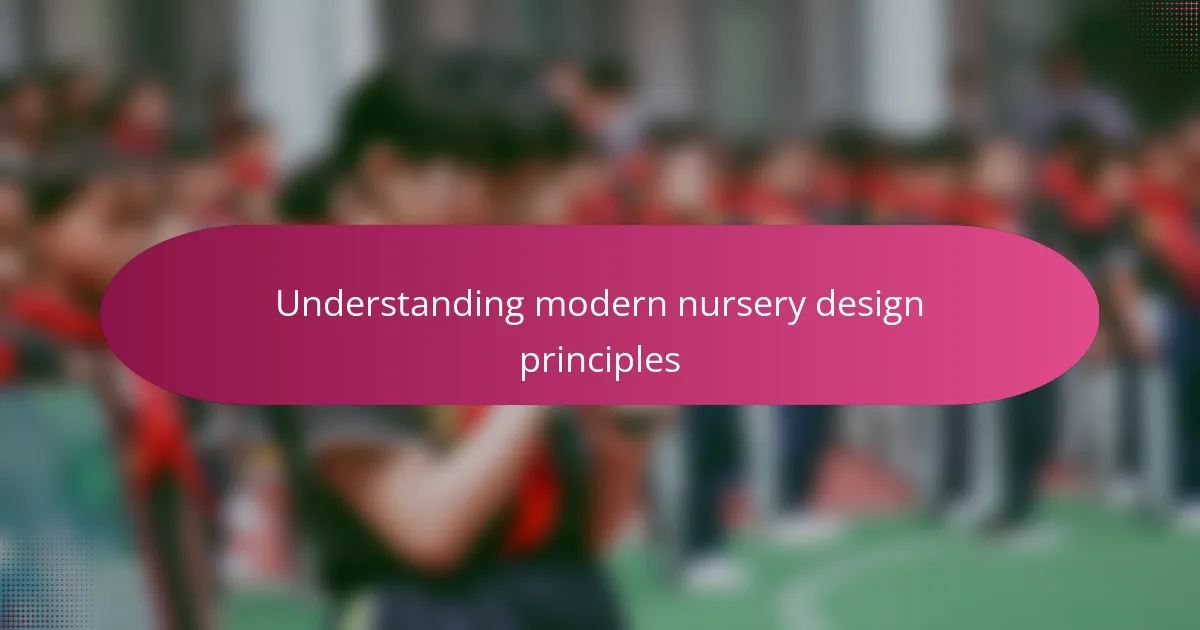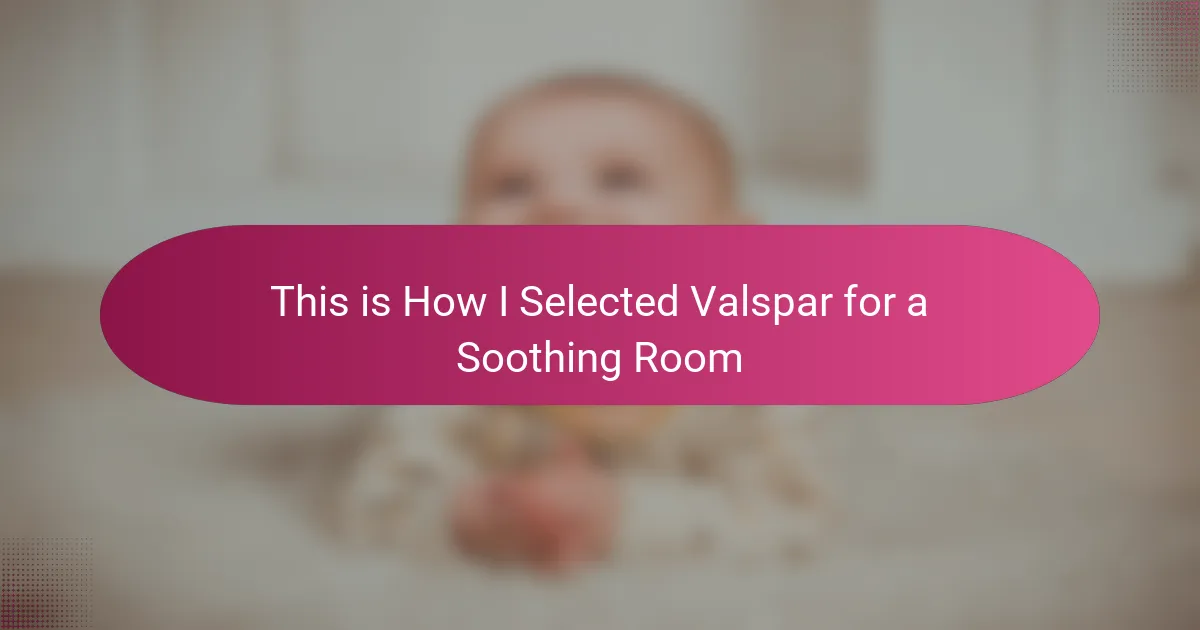Key takeaways
- Modern nursery design emphasizes calmness and functionality through soft colors, uncluttered layouts, and careful furniture selection.
- Soothing, muted colors contribute to a peaceful atmosphere, promoting relaxation for both baby and parents.
- Valspar paint is highlighted for its durability, low-VOC formula, and beautiful range of calming colors ideal for nurseries.
- Maintaining a relaxing nursery involves reducing clutter, using soft lighting, and controlling noise to create a serene environment.

Understanding Modern Nursery Design Principles
Modern nursery design is all about creating a space that feels calm, cozy, and safe for both baby and parents. I remember walking into a nursery where soft colors and uncluttered layouts immediately brought a sense of peace—I knew right then simplicity was key. Have you ever noticed how a well-designed room can almost whisper, “Relax here”? That’s the essence of these design principles.
Balancing functionality with beauty is another cornerstone. It’s not just about choosing pretty things; it’s about making sure every element serves a purpose without overwhelming the senses. I found this especially important when selecting furniture and décor that would grow with my child yet remain timeless.
Finally, natural light and gentle textures play a huge role. They create a soothing atmosphere that encourages restful naps and quiet moments. Think about how a soft breeze or warm sunlight makes you feel calm—modern nurseries try to capture that very feeling inside four walls.

Choosing Colors for Nursery Calmness
Colors have this incredible power to set the mood, especially in a nursery where calmness is essential. I remember staring at countless paint swatches, wondering which shades would actually help my baby relax instead of overstimulate. It made me realize that soft, muted tones—like gentle blues, greens, and warm neutrals—felt like a comforting hug rather than a jarring shout.
Have you ever noticed how certain colors just make you exhale and settle in? That’s what I was aiming for in the nursery. Rather than bold or bright hues, I leaned into subtle shades that encourage peace and quiet—perfect for those soothing lullabies and sleepy eyes.
Choosing the right color isn’t just about aesthetics; it’s about crafting an environment where calmness naturally unfolds. I found that when the walls whisper serenity, the whole room feels like a sanctuary, inviting moments of stillness and connection. Isn’t that what we all want for our little ones—a place that feels like a gentle retreat?

Why Soothing Colors Matter
Soothing colors matter because they create a gentle backdrop that helps ease both baby and parents into relaxation. I remember painting my nursery walls with soft, muted shades and instantly feeling a wave of calm wash over me—a simple change that made a huge difference in the room’s energy. Isn’t it amazing how just a color can soften the chaos of a busy day?
When I think about why these colors work, it’s clear they don’t demand attention but rather encourage quiet moments. That soft blue or warm gray feels like a pause button, allowing the mind to slow down and the body to breathe. Have you ever noticed how certain rooms just make you want to sit still and soak in the peace? That’s the power of soothing colors at play.
From my experience, these gentle hues also help create a sense of safety and comfort that babies respond to without feeling overwhelmed. It’s like wrapping the nursery in a soft blanket of calm that reassures everyone inside. Wouldn’t you agree that a room where everyone feels settled is the best kind of start for a child?

Benefits of Using Valspar Paint
Valspar paint stood out to me because of its impressive durability and easy application, which made painting the nursery less of a chore. Have you ever started a painting project only to get frustrated with streaks or uneven coverage? With Valspar, I barely needed more than two coats to get that flawless, soothing finish I was after.
Another thing I appreciated was Valspar’s low-VOC formula. Knowing that the paint was safer for my baby and had minimal odor gave me real peace of mind. When you’re creating a space meant to nurture and protect, aren’t these small details what truly matter?
On top of all that, Valspar offers a beautiful range of calming colors that felt like they were made for nurseries. I found it easy to pick shades that felt both modern and timeless, helping the room stay fresh as my child grew. Isn’t it wonderful when your color choice evolves naturally with your little one?

How I Selected Valspar for My Nursery
Choosing Valspar for my nursery was a decision shaped by both practicality and emotion. I remember standing in the paint aisle, overwhelmed by options, until Valspar’s collection of soft, muted shades caught my eye—colors that felt like they were made to cradle a baby’s first dreams. Don’t you think the right color can almost hold you?
What really sold me was how easy Valspar made the whole process. Painting a nursery felt daunting, but with this paint’s smooth coverage, I finished in no time, and the walls looked impeccable after just two coats. Have you ever experienced that satisfaction when a project goes better than expected?
I also felt reassured knowing Valspar’s low-VOC formula was safer for my baby. Creating a space that’s both beautiful and healthy mattered deeply to me. Isn’t peace of mind just as important as a pretty room when it comes to designing a nursery?

Applying Valspar for a Soothing Effect
Applying Valspar was surprisingly simple, and I could immediately see how its smooth finish enhanced the room’s gentle vibe. Have you ever painted a space and felt that the color itself just settled your thoughts? That’s exactly what happened here—the moment the first brushstroke went up, the nursery began to feel like a true haven.
What stood out most to me was how Valspar’s muted tones didn’t scream for attention but quietly invited calmness. It’s like the paint was whispering a lullaby to the space, encouraging both baby and parents to pause and breathe. Isn’t that soothing quality exactly what every nursery should have?
I also appreciated that with just two coats, the color was rich and even, which helped avoid that chaotic, patchy look that can disrupt a room’s peace. Knowing the paint would last through years of babyhood gave me a comforting sense of stability—because a nursery isn’t just for today, it’s for all the peaceful moments ahead.

Tips for Maintaining a Relaxing Nursery Environment
Keeping the nursery tidy was always a balancing act for me. I found that reducing clutter not only made the space safer for baby but also kept my mind at ease. Have you noticed how a neat, streamlined room just invites calm? That simple change really helped me maintain a soothing vibe day after day.
I also made a habit of using soft lighting to enhance the relaxing atmosphere. The right glow can transform even the busiest nursery into a peaceful retreat, almost like a gentle hug when the day winds down. Don’t you think lighting is one of those small details that quietly sets the mood?
Noise control was another thing I paid attention to. Using soft fabrics and curtains helped dampen sounds and created a cocoon of quiet that I found invaluable. It reminded me how much environment shapes our feelings—when the noise is low, the calm feels deeper and more genuine.
